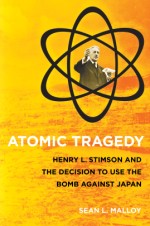UPDATE: “The Robert L. Capp collection at the Hoover Institution Archives at Stanford University contains ten photographs purportedly showing the immediate aftermath of the Hiroshima bombing. Mr. Capp was assigned to the occupation forces outside Hiroshima after World War II. According to to Mr. Capp’s oral history (available along with the photographs in the Robert L. Capp collection), he found these photos among rolls of undeveloped film in a cave outside of Hiroshima. Since making these photographs publicly available, I have received reliable proof that at least two of these photos are actually of the 1923 Kanto earthquake. While I cannot speak for the entire collection, this evidence raises doubts about all of the photos and raises the strong possibility that the identification provided by the Hoover Archives is incorrect. I take full responsibility for my own failure to take additional steps to verify that the original archival designation was correct. I have removed the photographs until and unless their source can be verified by further research.” MORE
ABOUT THESE PHOTOS: The Robert L. Capp collection at the Hoover Institution Archives contains ten never-before-published photographs illustrating the immediate aftermath of the Hiroshima bombing. These photographs, taken by an unknown Japanese photographer, were found in 1945 among rolls of undeveloped film in a cave outside Hiroshima by U.S. serviceman Robert L. Capp, who was attached to the occupation forces. Unlike most photos of the Hiroshima bombing, these dramatically convey the human as well as material destruction unleashed by the atomic bomb. Mr. Capp donated them to the Hoover Archives in 1998 with the provision that they not be reproduced until 2008. Three of these photographs are reproduced in Atomic Tragedy with the permission of the Capp family. Now that the restriction is no longer in force, the entire set is available below. Please contact Sean L. Malloy (smalloy@ucmerced.edu) if you have any information that might help identify the original photographer. MORE
 CORNELL UNIVERSITY PRESS: Atomic Tragedy offers a unique perspective on one of the most important events of the twentieth century. As secretary of war during World War II, Henry L. Stimson (1867–1950) oversaw the American nuclear weapons program. In a book about how an experienced, principled man faltered when confronted by the tremendous challenge posed by the intersection of war, diplomacy, and technology, Sean L. Malloy examines Stimson’s struggle to reconcile his responsibility for “the most terrible weapon ever known in human history” with his long-standing convictions about war and morality. Ultimately, Stimson’s story is one of failure; despite his beliefs, Stimson reluctantly acquiesced in the use of the atomic bomb against heavily populated Japanese cities in August 1945. This is the first biography of Stimson to benefit from extensive use of papers relating to the Manhattan Project; Malloy has also uncovered evidence illustrating the origins of Stimson’s commitment to eliminating or refining the conduct of war against civilians, information that makes clear the agony of Stimson’s dilemma.
CORNELL UNIVERSITY PRESS: Atomic Tragedy offers a unique perspective on one of the most important events of the twentieth century. As secretary of war during World War II, Henry L. Stimson (1867–1950) oversaw the American nuclear weapons program. In a book about how an experienced, principled man faltered when confronted by the tremendous challenge posed by the intersection of war, diplomacy, and technology, Sean L. Malloy examines Stimson’s struggle to reconcile his responsibility for “the most terrible weapon ever known in human history” with his long-standing convictions about war and morality. Ultimately, Stimson’s story is one of failure; despite his beliefs, Stimson reluctantly acquiesced in the use of the atomic bomb against heavily populated Japanese cities in August 1945. This is the first biography of Stimson to benefit from extensive use of papers relating to the Manhattan Project; Malloy has also uncovered evidence illustrating the origins of Stimson’s commitment to eliminating or refining the conduct of war against civilians, information that makes clear the agony of Stimson’s dilemma.
The ultimate aim of Atomic Tragedy is not only to contribute to a greater historical understanding of the first use of nuclear weapons but also to offer lessons from the decision-making process during the years 1940–1945 that are applicable to the current world environment. As the United States mobilizes scientists and engineers to build new and supposedly more “usable” nuclear weapons and as nations in Asia and the Middle East are replicating the feat of the Manhattan Project physicists at Los Alamos, it is more important than ever that policymakers and analysts recognize the chain of failures surrounding the first use of those weapons at Hiroshima and Nagasaki. MORE
